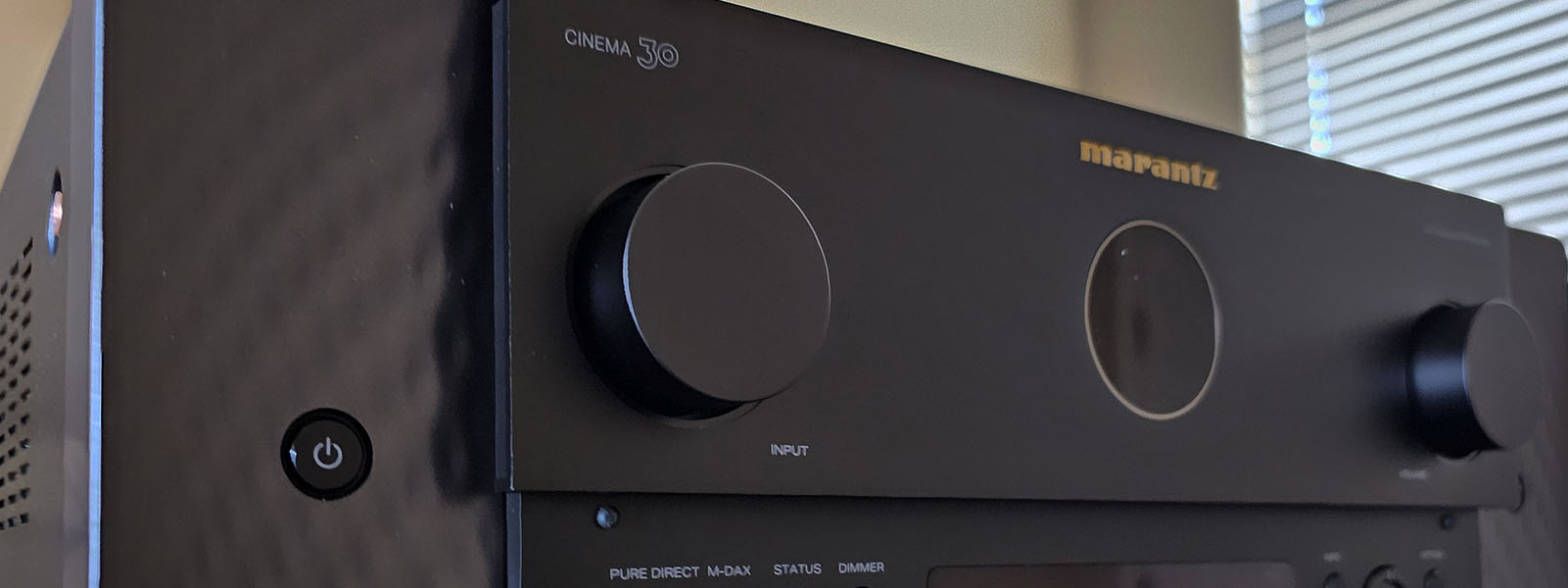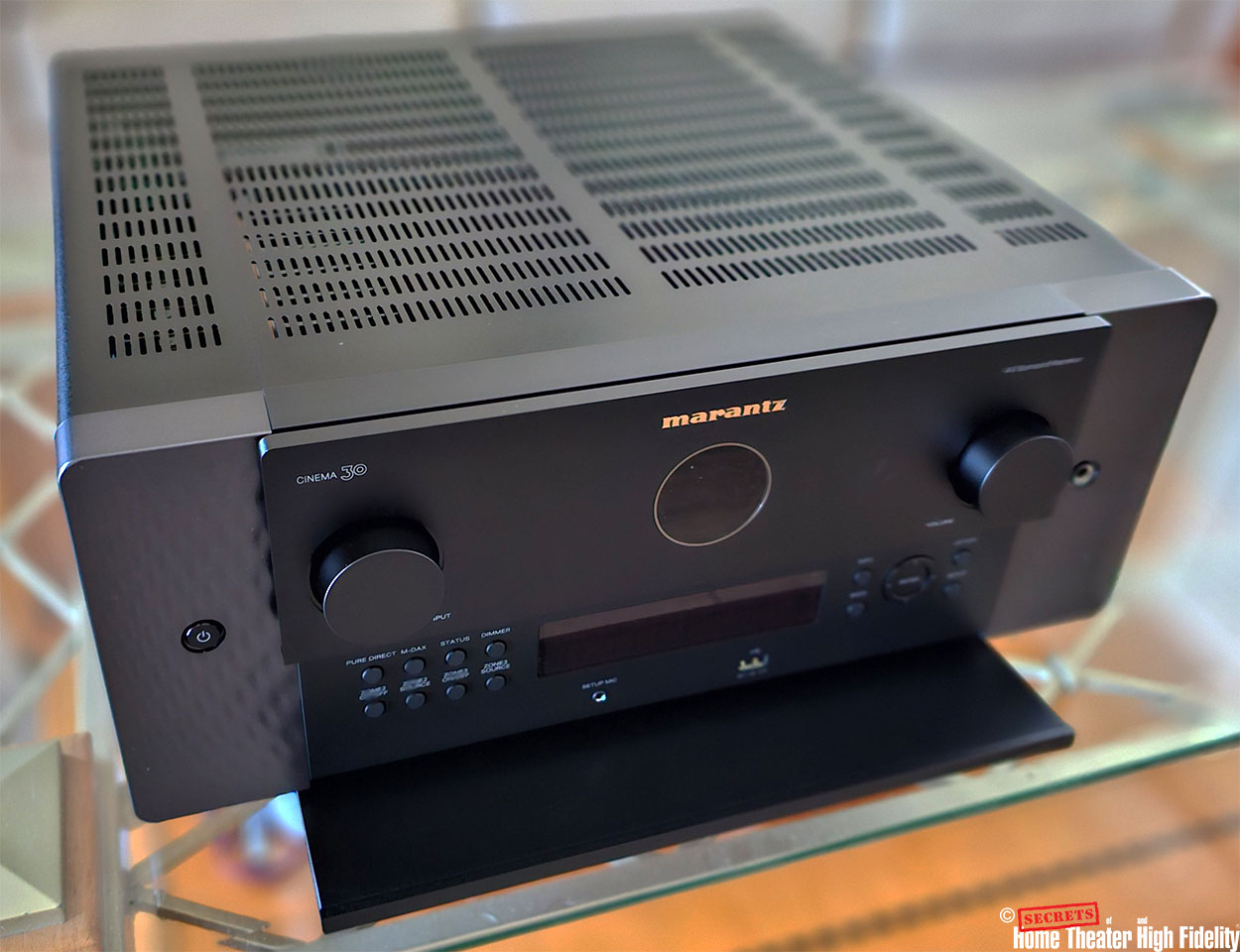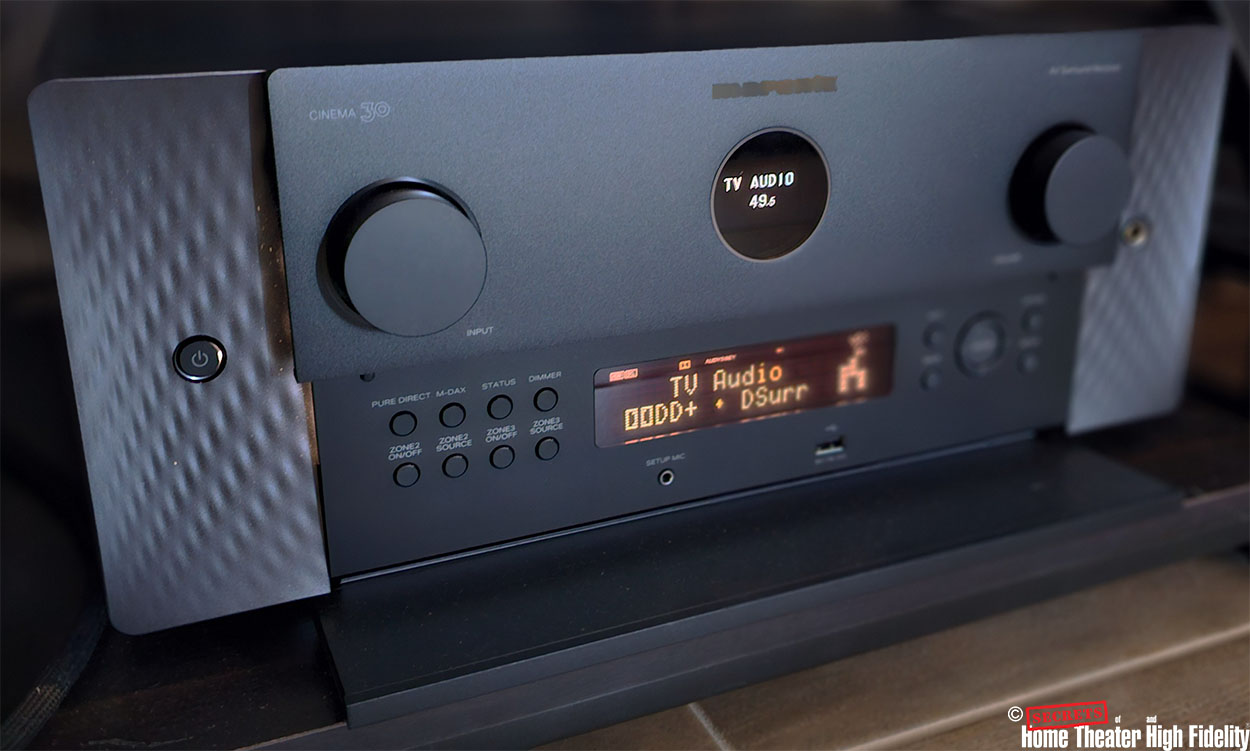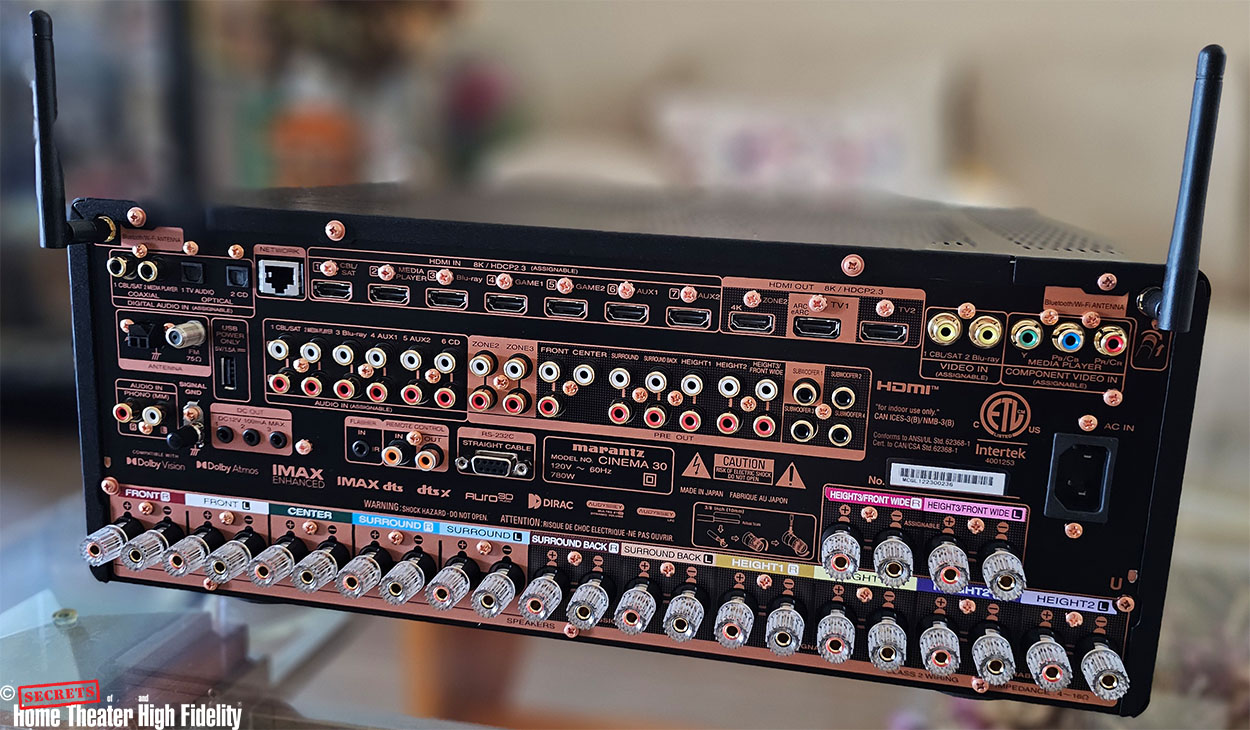 Marantz Cinema 30 front plate closeup view
Marantz Cinema 30 front plate closeup view
When I reviewed it last year, the Marantz CINEMA 40 was sitting as the top-of-the-line receiver in the CINEMA series. I liked the receiver very much; I purchased the review sample. But the CINEMA 40 did not stay at the CINEMA series throne for too long. The flagship position is now relegated to the new king in town, the CINEMA 30, which boasts more features and costs a grand more than the CINEMA 40. This review will specifically look at what the CINEMA 30 brings to the table besides more processing channels and a more powerful onboard amplifier.
Marantz CINEMA 30 AV Receiver Highlights
- 11.4-channel AV receiver with 11 x 140 W onboard amplification.
- Four independently adjustable subwoofer outputs.
- Dolby Atmos, DTS:X, and Auro-3D surround processing formats.
- 8K Ultra video upscaling and HDMI pass-through with HCDP 2.3 support.
- Dirac Live upgradeability.
- Wireless app and HEOS (Home Entertainment Operating System) control features.
With the popularity of the CINEMA series, Marantz further cements its reputation as one of the leaders in the home AV industry. Many AV enthusiasts, including me, consider AV receivers from the CINEMA series as the frontrunners in their respective classes. Having reviewed two of the receivers from the CINEMA series, the CINEMA 60 and CINEMA 40, I can attest to the no-nonsense features and performance offered by this series’ products.
The recently released CINEMA 30 fills in the void that is left by the SR8015, the top-of-the-line receiver from the previous SR series, which has been phased out from the company’s product lineup. The CINEMA 30 now holds the flagship position of the CINEMA receiver series and as such it is equipped with the most comprehensive features of the bunch. The two top receivers in the series, the CINEMA 40 and CINEMA 30, which Marantz designates as Reference products, seem to get special treatment. While the other CINEMA series receivers are manufactured at Marantz’s factory in Vietnam, the CINEMA 40 and CINEMA 30 are crafted at Marantz’s home factory in Shirakawa, Japan, just like the other Marantz higher-end products.
A glance at the features of the CINEMA 30 confirms that this is indeed a comprehensively equipped state-of-the-art receiver. It is an 11.4-channel receiver with an 11-channel onboard amplifier which is two more amplification channels than its direct sibling, the CINEMA 40. The CINEMA 30 can also process 13.4 channels of content as opposed to the 11.4 processing channels in the CINEMA 40. This review will evaluate all the features of the CINEMA 30 and the performance that it can deliver. Comparisons to the CINEMA 40 will be made in various parts of the review as I believe this would be of interest to many readers.
Power Amplifier
Number of Powered Channels:
11
Power Output (8 ohms, 20 Hz – 20 kHz, 0.05% 2ch driven):
140 W
Power Output (6 ohms, 1 kHz, 0.7% 2ch driven):
175 W
Amplifier Topology:
Class A/B
Multichannel Surround Technologies
DTS:
DTS HD Master, DTS:X, DTS Neural:X, DTS Virtual:X
Dolby:
Dolby TrueHD, Dolby Atmos, Dolby Atmos Height Virtualization, Dolby Atmos Music, Dolby Surround
Others:
Auro 3D, 360 Reality Audio/MPEG H, Multichannel Stereo
Max Number of Processing Channels:
13.4
Inputs/Outputs
HDMI In / Out:
7 / 3
Composite In / Out:
2 / 0
Component In / Out:
1 / 0
Analog In / Fixed Level Out:
7 in (including MM Phono) / 0 out
Digital In: Optical / Coaxial:
2 / 2
Multi-Room Out: analog/digital:
2 / 0
Multichannel Preamp Out:
13.4
Subwoofer Out:
4 (independent)
Number of Speaker Terminals:
13
Multi-Room Speaker Terminal:
Assignable
Front Inputs:
USB-A
AM/FM Tuner:
Yes
HDMI
Total HDMI Inputs / No. Support 8K:
7 / 7
HDCP2.3 support:
Yes
HDMI Outputs: Main / Zone:
2 / 1
HDMI Upscaling:
1080P/4K to 8K
Max resolution @ framerate:
8K @ 60Hz, 4K @ 120Hz
Audio Return Channel:
ARC, eARC
Video Dynamic Range:
HDR, HLG, Dolby Vision, HDR10+, Dynamic HDR
Other HDMI features:
HDMI Pass-Through in Standby Mode, CEC, Auto Lipsync
Other Features
Acoustic Room Correction:
Audyssey MultEQ XT32
Music File Support:
Lossy formats: MP3, WMA, AAC
Lossless formats: FLAC HD 192/24, WAV 192/24, ALAC 192/24, DSD 2.8 MHz / 5.6MHz
Streaming Features:
HEOS, AirPlay 2
Network Connectivity:
Ethernet, Wi-Fi, Bluetooth (including retransmit for Bluetooth headphones)
Smart Home Integration:
Alexa, Google Voice Assistant, Apple HomePod
Control Connectivity:
IP Control, RS232 Control, Web Control, App Control (Marantz AVR Remote App, HEOS)
Front Display:
2-line FLD + port hole OLED
General
Available Colors:
Black / Silver-Gold
Power Consumption:
780 W
Standby Consumption:
0.2 W
Network Standby Consumption:
Less than 2.0 W
Dimensions without antenna (W x D x H):
17.4″ x 17.6″ x 7.5″
Weight:
42.8 lbs.
MSRP:
$4,500.00
Company:
SECRETS Tags:
Marantz, A/V, Receiver, CINEMA 30
 Marantz CINEMA 30 receiver front view
Marantz CINEMA 30 receiver front view
Secrets Sponsor
Except for the CINEMA 30 logo, the front fascia of the CINEMA 30 receiver is almost identical to the CINEMA 40, as they share the same width and height, the same finish color options (grey/black or silver/gold), and the same two-layer faceplate design style that looks premium while still paying homage to Marantz’s classic porthole display and symmetrical knobs configuration. It also has a bottom-hinged flap that keeps the front panel looking clean and uncluttered when closed by cleverly hiding some front connectors and controls as well as a two- line FLD display. Both the porthole and FLD displays can be dimmed or turned off altogether.
Despite the front-panel similarity, the CINEMA 30 is almost 2 inches deeper than the CINEMA 40. Their weights are also substantially different. The CINEMA 30 is about 10 lbs. heavier than the CINEMA 40. The build quality of the receiver is excellent. A partial contributor to this weight difference is the large toroidal transformer used in the CINEMA 30. The CINEMA 40 uses a lighter EI-type transformer. This does not mean that the EI-type transformer is worse than the toroidal one but, for applications in high-power amplifiers, the toroidal transformer has been shown to generate better overall performance. Toroidal transformers are more efficient and radiate less noise to surrounding electronics. The trade-off is they are more expensive than the EI-type ones.
Feature-wise, there are a lot of similarities between the CINEMA 30 and the CINEMA 40. Both receivers are equipped with state-of-the-art audio and video processing features. The additional channels in processing and amplification are some of the differentiating features that have been mentioned but there are others. The CINEMA 30 is equipped with 32-bit ESS Sabre DAC chips that are of higher performance than the ones in the CINEMA 40. The CINEMA 30 also utilizes a copper- plated chassis not found in the CINEMA 40 and other CINEMA series receivers. The copper-plated chassis provides better ground connection and improves the overall signal-to-noise ratio. The class A/B amplifier in the CINEMA 30 is also the most powerful in the series, capable of producing 140 W/channel into 8-ohm loads with 2 channels driven, which should be plentiful for most home applications. Six of the 11 amplification channels are assignable to accommodate various kinds of speaker configurations. The receiver itself has 13 channels of processing capability. To utilize all the 13 channels, an external two-channel amplifier or active speakers will be needed to complement the 11-channel onboard amplifier.
The CINEMA 30 is capable of decoding state-of-the-art discrete multichannel audio formats including Dolby Atmos with Height Virtualization, DTS:X with Virtual:X, IMAX Enhanced technology, and Auro-3D processing. It also offers 4 discrete subwoofer low-level outputs, a feature that I really like as I think it improves the overall bass response a great deal. The bass management feature included in the receiver is sufficiently comprehensive, allowing the bass mode to be set to Standard which directs mono signal containing LFE plus the bass from any “small” speakers to all subwoofers, or Directional which directs different signals to each subwoofer, containing the output bass below the crossover frequencies of the nearby “small” speakers in addition to the LFE signals. In the Directional mode, the subwoofer configurations available include front-left/front-right or front/rear for 2 subwoofers, front-left/front-right/rear for 3 subwoofers, and front-left/front-right/rear-left/rear-right for 4 subwoofers.
The rear panel of the CINEMA 30 offers a glimpse of its extensive connectivity. On the video side, there are 7 HDMI inputs (all with HDCP2.3 and up to 8K 60 Hz video support) and 3 HDMI outputs (1 with eARC/ARC). The HDMI connection can upscale HD video to Ultra HD (up to 8K) and accommodates high video dynamic range (including HDR, HDR10+, and Dolby Vision) as well as a pass-through feature in standby mode. With the provision of two composite and one component video inputs, the CINEMA 30 also offers backward compatibility with older non-HDMI video devices.
On the audio side, the receiver can accept 6 analog line-level and 1 MM phono inputs. It also provides 2 coaxial and 2 optical digital inputs. Multi-channel pre-outs (13.4) are provided for use with external amplifiers or powered subwoofers. There are 13 pairs of five-way binding-post speaker terminals, 8 of which are assignable.
Besides the standard Audyssey MultEQ XT32 automatic setup and room calibration system that comes with the receiver, the Dirac Live room calibration with its higher degree of adjustability is also offered as an optional upgrade. The cost of such an upgrade is $259 for the limited version (up to 500Hz) and $349 for the full-bandwidth version (20Hz – 20KHz). Only the included Audyssey calibration system was utilized for this review.
The CINEMA 30 can be connected to the local network using a wired (ethernet LAN) or wireless (Wi-Fi) connection. Although connection to the network is not mandatory for the operation of the receiver, I definitely recommend it as, without it, some of its features cannot be used such as music streaming through HEOS (Home Entertainment Operating System), voice command functions (using Amazon Alexa, Google Assistant, or Apple HomePod), and app control features (using Marantz AVR Remote app which is available in Android or iOS versions). I especially like the versatility of the Marantz AVR Remote app which can be used not only to control the operations of the receiver but also to modify some of its settings on the fly without accessing the receiver’s menu.
The CINEMA 30 can stream music through Bluetooth, AirPlay, or broadband networks via the built-in HEOS feature which can be linked to the Marantz AVR Remote app. HEOS serves as a platform for streaming from popular services such as TIDAL, Spotify, Pandora, Deezer, and iHeart Radio or from a local NAS server. There is no Qobuz support through the HEOS app currently. The CINEMA 30 can handle streaming playback of PCM signals up to 24-bit/192-kHz and DSD signals up to 5.6 MHz (DSD128).
The remote control of the CINEMA 30 has a similar form factor and appearance to the ones coming with the other CINEMA receivers. However, it is of more premium quality. Instead of an all-plastic enclosure, the CINEMA 30’s remote has a metal faceplate which makes it feel sturdy. This remote has nicely laid-out buttons and sits in hand nicely. With its backlit feature, it can easily be used in a dark room. Although I used the Marantz AVR Remote app more often for changing the surround modes or making setting adjustments on the fly during day-to-day usage, I found that the remote was still handy for quick tasks such as changing inputs or making volume adjustments.
 Marantz CINEMA 30 remote control
Marantz CINEMA 30 remote control
Setting up the CINEMA 30 was relatively straightforward. Marantz’s on-screen step-by-step setup guide is easy to follow, and I think it is one of the best in the business. Nine speakers were used for the review’s surround setup in a 7.2.2 configuration with the Revel Ultima Studio pair for the two front mains, the Revel C50 for the center channel, the Revel Concerta M8 speakers, and the NHT Absolute Wall speakers for the surrounds along with back surrounds and height channels. Two SVS SB-3000 subwoofers were utilized in the front-left and front-right positions. The Xfinity X1 4K TV box and an Oppo UDP-203 universal disc player were used as the HDMI sources during the review. Other audio-only sources used were an AURALiC Aries G1 streamer, a Music Hall Classic turntable, and a PS Audio DirecStream DAC. The eARC HDMI port was connected to my HiSenseU7K75″ television. Sound calibration and room equalization using the included Audyssey MultEQ XT32 system yielded excellent results with only minor adjustments made post-calibration to better fit my preferences. Directional subwoofer mode was applied to the two subwoofers used in the setup.
The video switching features of the CINEMA 30 are state-of-the-art with the inclusion of the 8K video switching capability. As I did not have the means to test its 8K video functionality, I could not say much about its performance in this regard. However, for up to 4K video resolutions, the receiver performed upscaling and video switching adeptly. In comparison between the video signals switched through the receiver versus the ones sent to the TV directly, I did not notice any discernable artifacts that degraded the video quality. Its upscaling feature worked flawlessly. I usually engaged the HDMI-CEC control feature for convenience and, for the most part, it worked as expected in turning on/off the receiver automatically as I turned on/off the TV and in switching from TV audio to another HDMI input or vice versa. A few times during the review period, I experienced glitches where the switching of the HDMI input mode was not recognized but I did not consider it as a big deal since it happened rarely. Also, it might not be solely due to the receiver. More often than not, such issues were due to the handshake connectivity between the TV and the receiver.
 Marantz CINEMA 30 in operation
Marantz CINEMA 30 in operation
Impressively, the CINEMA 30 still managed to squeeze out sonic improvement over the already solid performance of the CINEMA 40. Maybe the extra amplifier power or perhaps the improved power supply but, regardless, the CINEMA 30 sounded a tad clearer and more refined overall over the CINEMA 40. Sound edges in music or movies seemed to be better defined without the increase in brightness. There was a touch of warmth in the sonic character of the receiver which made it non-fatiguing to listen to for a long duration of time. Moreover, the CINEMA 30 maintained its composure better in high-volume applications involving highly dynamic soundtracks. This was not a knock on the CINEMA 40 which, in my opinion, was still one of the better-sounding receivers on the market. The CINEMA 30 just happened to be slightly better in the sonic department.
Especially in stereo music applications, the CINEMA 30 exhibited competency in music reproduction more than any of the other receivers that I have auditioned. Solid midrange, detailed highs, and great spatial rendition are the highlights of the CINEMA 30’s sonic excellence. This was generally true for both the digital and the analog sources I tried, showing the prowess of the CINEMA 30 in such applications. The sonic performance and characteristics of the CINEMA 30 reminded me of the Marantz Model 40n integrated amplifier that I reviewed a while back which won me over with its solid stereo performance. Although my opinion was based on my recollection (as I no longer had the Model 40n in hand for direct comparison) the fact that the CINEMA 30 could put out a stereo performance that belongs in the same conversation as that of the Model 40n, a specialist two-channel product, is by no means a small feat.
 Diana Krall’s Wallflower (2014) album cover
Diana Krall’s Wallflower (2014) album cover
Diana Krall, “Wallflower (2014)”
The track Sorry Seems To Be The Hardest Word from Diana Krall’s Wallflower album (2014), which I streamed from Tidal through HEOS, exemplified the CINEMA 30’s stereo playback competence, resulting in a very satisfying rendition of the track. Diana Krall’s voice sounded natural accompanied by realistic conveyance of her breathing and sibilance that was captured in the recording. The spatial cues in the music were rendered beautifully by the CINEMA 30, projecting a realistic presentation of the intimate musical stage. Overall, the greater sense of musicality in the CINEMA 30’s stereo presentation sets it apart from its competitors.
On the surround side, the CINEMA 30 never failed to produce an immersive listening experience. Although I rarely listened to music in surround mode (unless it is part of movies), I found that the surround music upmixed playback through the CINEMA 30 could be quite enjoyable for casual listening. But not all surround upmixers are created equal. The results from the surround upmixers in the CINEMA 30 such as Dolby Surround, DTS Neural:X, and AURO-3D, could vary a great deal and not all were to my liking. Of the available upmixers in the CINEMA 30, my favorite was AURO-3D which, in my opinion, enhanced the spatial ambience of the playback while preserving the front musical soundstage presentation. Your mileage may vary.
In home-theater applications, the CINEMA 30 showed prowess in creating an immersive surround-sound experience with its accurate surround steering and great sonic balance across the audio spectrum. As also noted in my review of the CINEMA 40, the Directional subwoofer mode generated better overall bass response than the Standard (mono) subwoofer mode. Not only did the Directional mode deliver a more even bass response from multiple-subwoofer application but it also enhanced the low-frequency directional effects. The CINEMA 30 might become rather warm to the touch when driven hard to a very loud volume level but it never seemed to run out of steam. In this regard, the CINEMA 30, with its more powerful amplifier, has an edge over the CINEMA 40. At the volume level that the CINEMA 40 started showing signs of strain, the CINEMA 30 was still maintaining its composure well.
 House of Ninjas (2024) series cover art
House of Ninjas (2024) series cover art
Netflix, “House of Ninjas (2024)”
The CINEMA 30 definitely elevated my enjoyment in watching Netflix’s House of Ninjas (2024) series. More than most other movies/series, House of Ninjas uses music in surround fashion, I might add, to effectively set the emotions and moods of the scenes. The sounds of musical instruments were intentionally mixed to appear from various directions in some scenes to convey the emotional state associated with the scenes. Various types of music were utilized in the series; some were smooth and flowing, and others were dynamic and impactful. On top of that, the surround effects throughout the series were lively and used immensely. The soundtrack of this series was quite revealing to the sonic quality of the device used to decode it. Impressively, the CINEMA 30 navigated through all these demanding tracks with flying colors, indulging me with the proper moods and emotions as well as effectively conveying the scene’s impacts. Watching this series with just the TV’s built-in speakers gave me a night-and-day experience which substantially reduced the level of enjoyment. It took away the grand vibe of the movie by depriving me of the three-dimensional atmosphere depicted in its scenes. House of Ninjas is really the type of movie that exemplifies the advantages of a good surround setup to deliver an enhanced watching experience.
 The Marvels (2023) cover art
The Marvels (2023) cover art
Disney+, “The Marvels (2023)”
Disney’s The Marvels (2023) is another movie with great surround effects. The movie itself was not that memorable, however, the soundtrack of the movie was quite dynamic and exciting. And the CINEMA 30 delivered the Dolby Atmos soundtracks of the movie with aplomb. Dialogue sounded clear and remained intelligible in the complex parts of the soundtracks where dialogue appeared in the middle of the busy sound effects. Again, the lateral and vertical surround effects and the sonic envelopment that the CINEMA 30 generated were awesome, conveying the sense of space in the scenes with a high degree of realism.
Secrets Sponsor
While best is relative, the Marantz CINEMA 30 convincingly makes its case to be considered as the best in class with its little-to-no-compromise all-around performance worthy of its top-of-the-line status.
- Great build quality and appealing look
- Inclusion of Auro-3D surround processing
- Four discrete subwoofer outputs
- HEOS built-in
- Powerful onboard amplifier
- Excellent stereo and surround performance
- Backlit remote control
- App control feature
Without a doubt, Marantz CINEMA 30 is an immensely impressive receiver. As the current top-of-the-line receiver in the CINEMA series, Marantz really dressed the CINEMA 30 to the nines, equipping it with advanced features including state-of-the-art audio and video processing and more amplifier channels and power than the other receivers in the series. It is solidly built and sports the handsome Marantz unique two-tone faceplate design style. More importantly, as I have discovered during this review, the receiver exhibits the best sonic performance of the bunch. The CINEMA 30 is not cheap but it is hard to argue that it is among the best for delivering awesome sonic performance in both stereo and surround applications. If you want a one-box entertainment hub that delivers excellent all-around performance, the CINEMA 30 might be the ticket that you are looking for. In the sub-$5000 receiver category, it is hard to think of something better.




